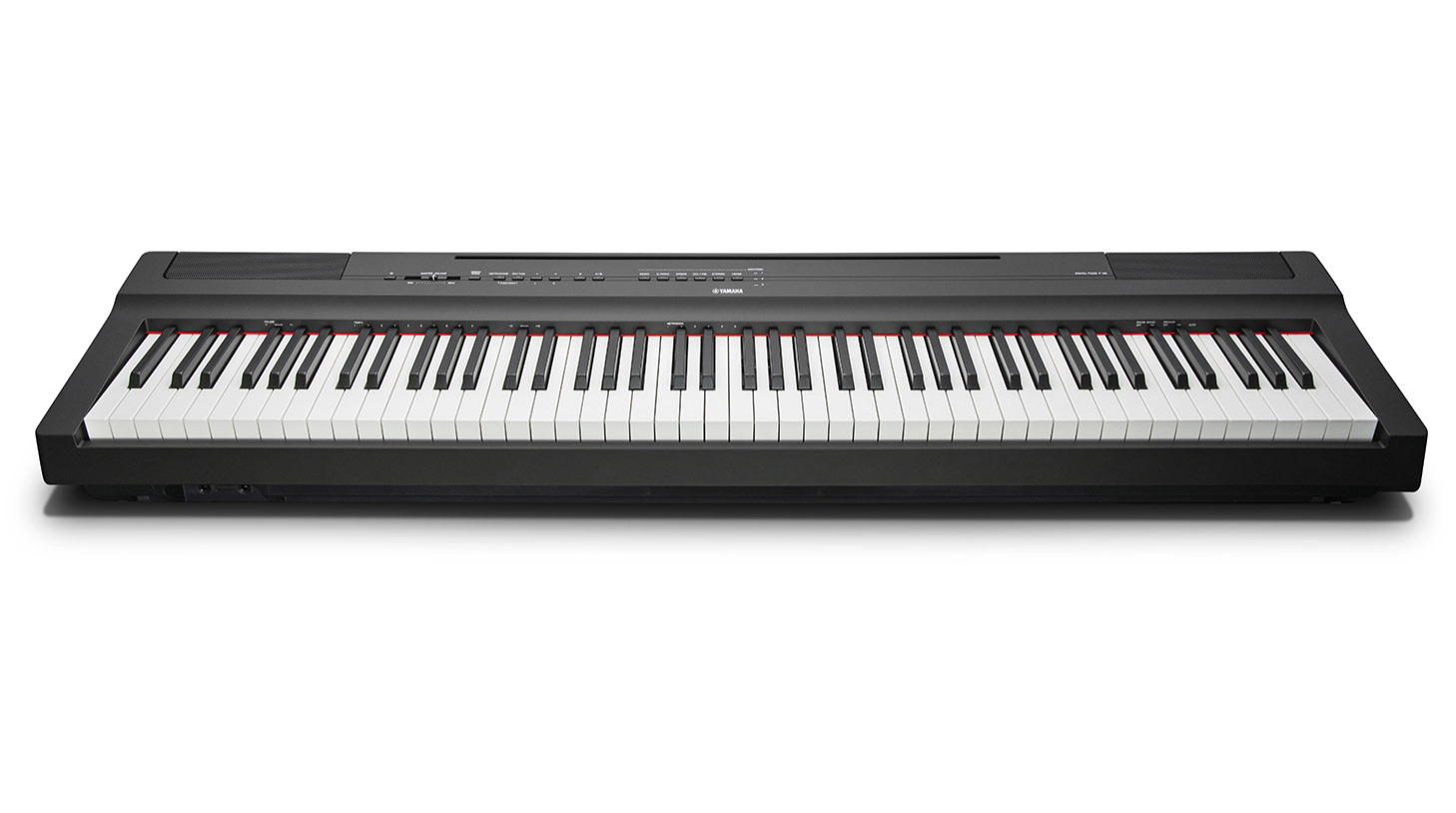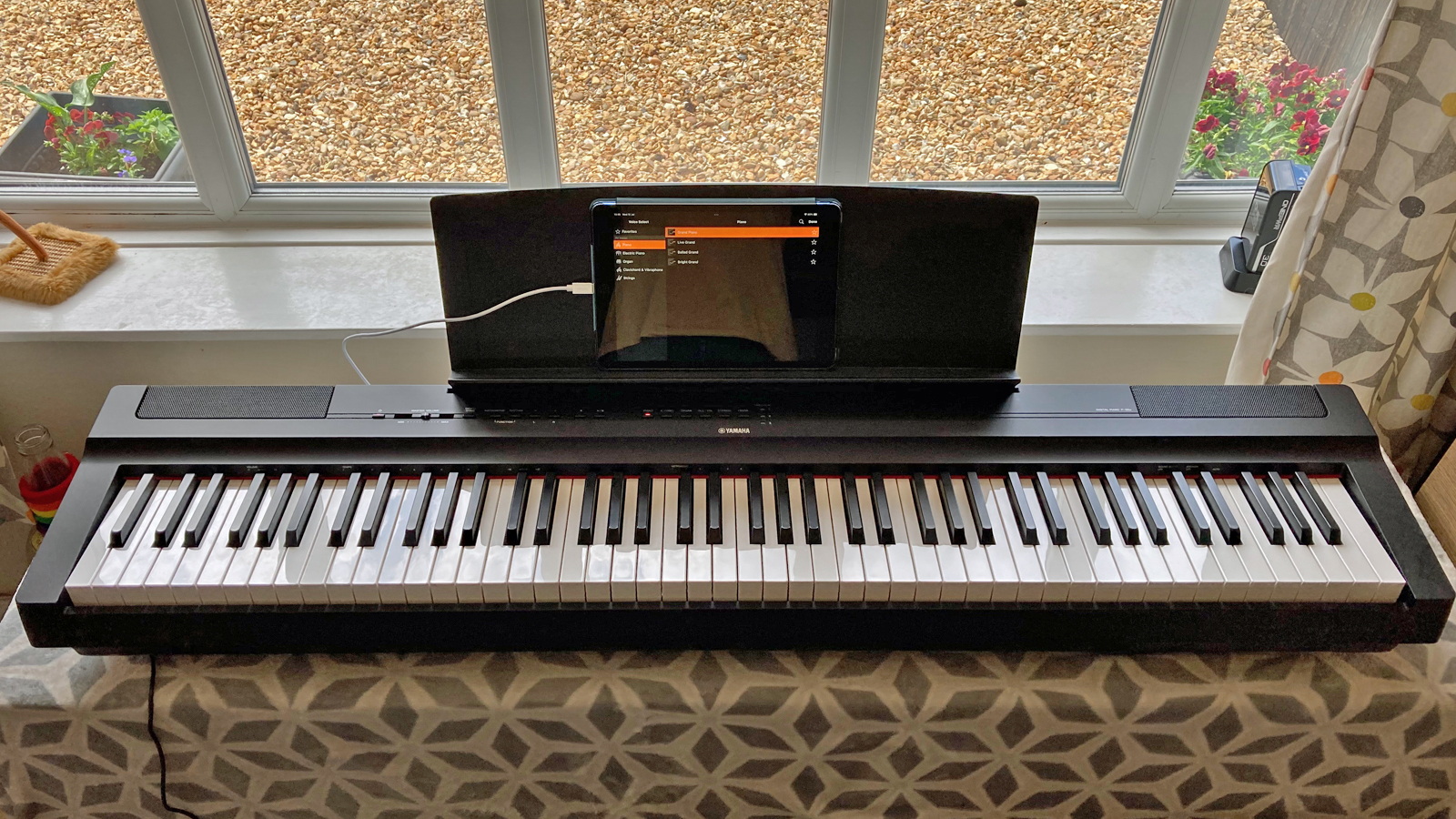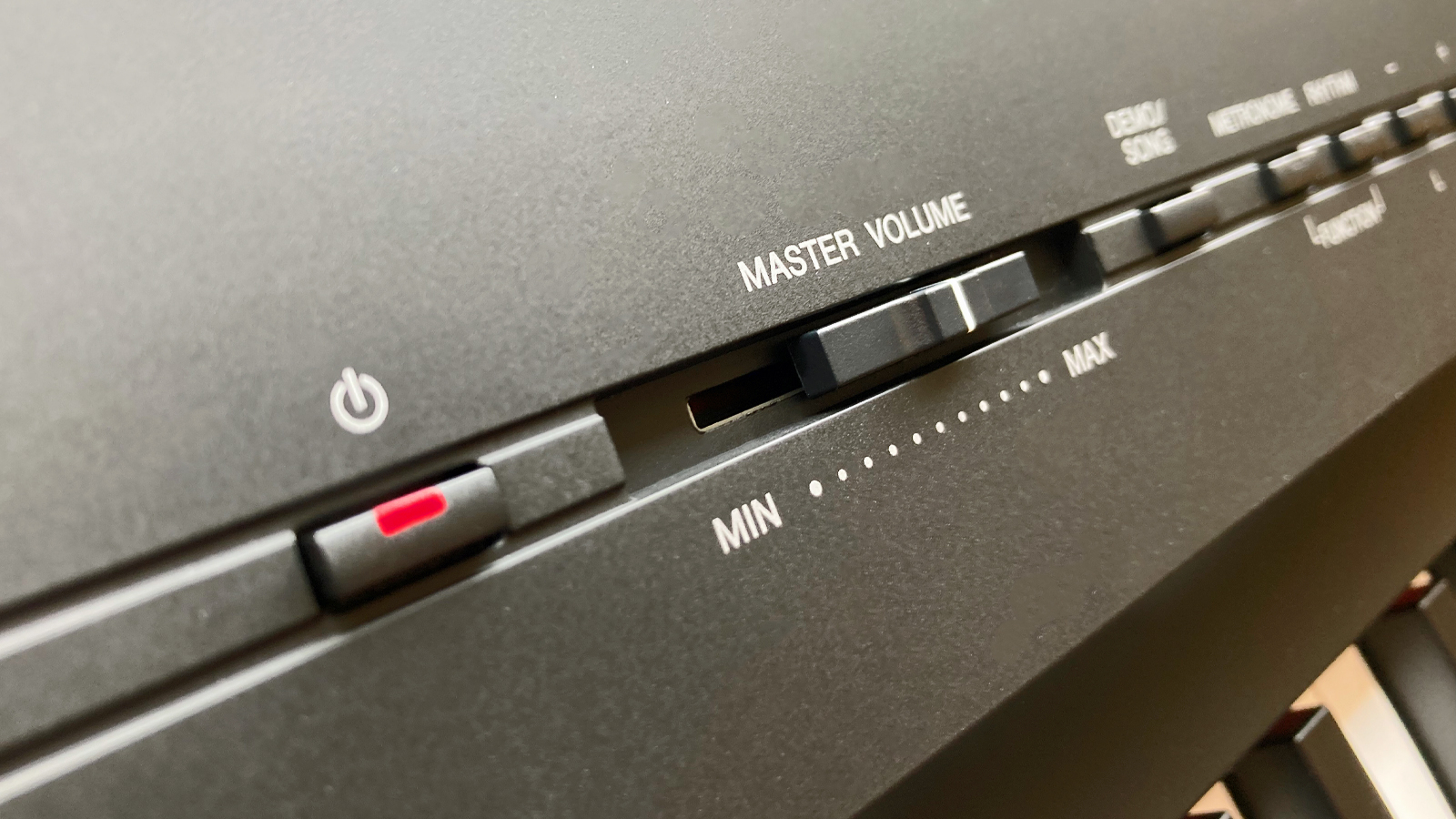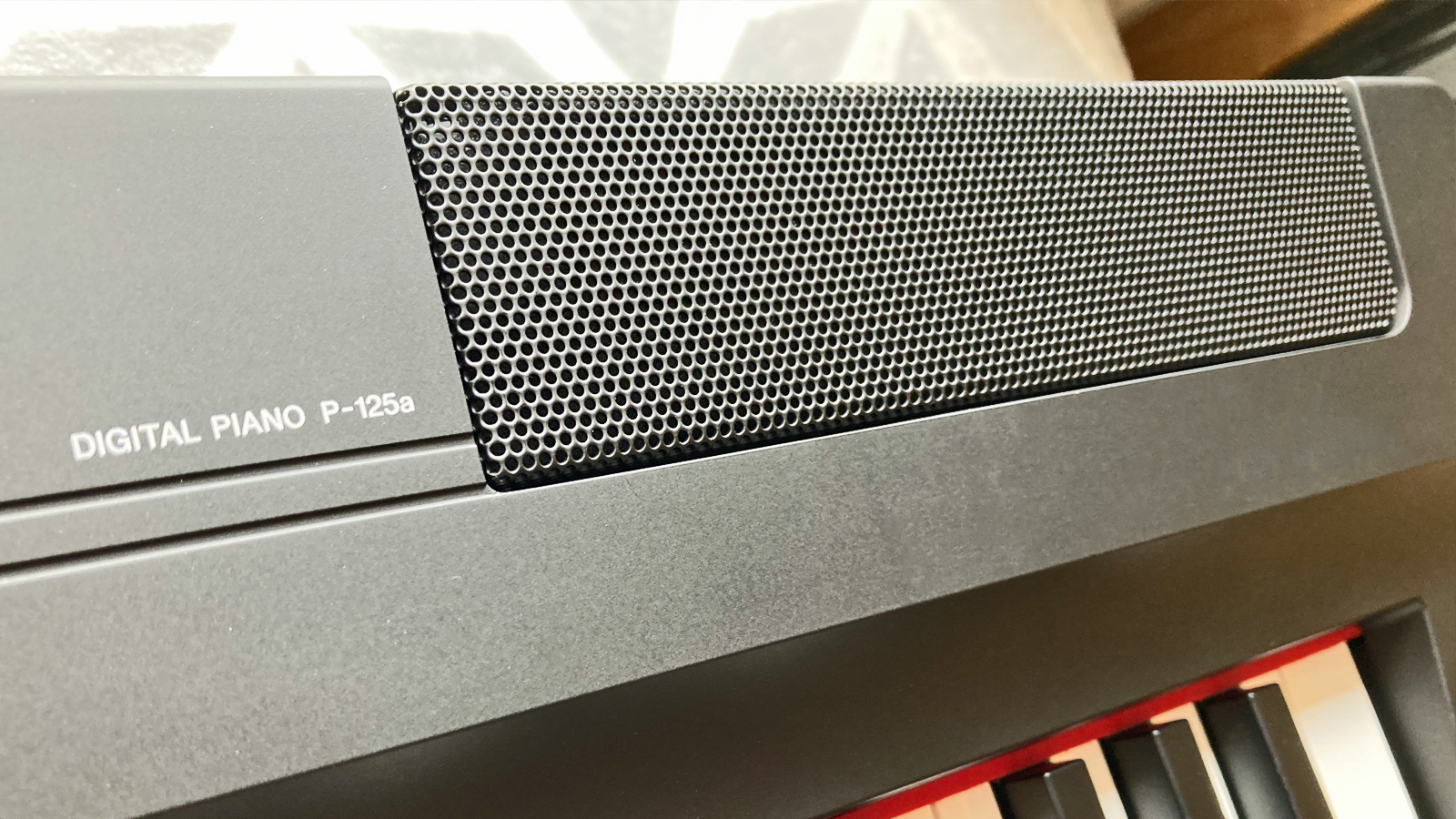
Yamaha P-125a review: What is it?
A step up from the entry-level P-45 model in the company’s lineup, the Yamaha P-125a is a fully-weighted, 88-key portable stage piano that features 24 piano, electric piano and other ‘bread and butter’ voices, a 2-way speaker system that fires both upwards and downwards for an expansive piano sound and 20 drum rhythms and auto-generated bass patterns to play along with.
The P-125a replaces the previous P-125 model, the only apparent difference being that audio is no longer transmitted digitally through the USB port. We’re not sure what prompted the decision to remove this function. Still, unless the lack of a built-in audio interface is a deal breaker for you, it doesn’t detract from the P-125a’s extraordinary piano sound and playability.
The physical footprint of the P-125a is not a lot larger than the keyboard itself, with a slim control panel running the full width of the instrument and housing speakers situated at each end. The surprising dimension is the height - presumably to accommodate the 2-way speaker system and the weighted keyboard mechanism, the chassis is pretty tall, giving the instrument a height, when placed on a flat surface, of 16.6cm. Since this is a portable piano, Yamaha have done an excellent job of keeping the overall weight down to a manageable 11.8kg. There are plenty of recesses on the underside to get your fingers into, making it easy to lug the unit around, but it’s only capable of running on mains power - no batteries here.
Round the back, we have a pair of L/R auxiliary outputs, a USB to host port and sockets for a sustain pedal and Yamaha’s bespoke LP-1 three-pedal unit (sold separately). The rear connectors are tucked away so far back into the recess on the underside of the piano that you have to practically invert your entire upper body to get to them from the player’s point of view, but thankfully the two 6.3mm headphone outputs are located more accessibly on the front of the instrument, on the left-hand side.
Our review model included a power supply, music rest and a footswitch-style damper pedal, but we were also sent an optional FC3A pedal that looks and behaves more like a regular piano damper pedal, with support for half-pedalling. Also available as an extra alongside the LP-1 pedal unit is the L-125, a flatpack wooden stand that turns the P-125a into more of a traditionally-styled console piano for those who require a more permanent setup.
Performance and Verdict

Yamaha are one of the few top digital piano manufacturers that also have a long tradition of crafting acoustic instruments, and it shows particularly well in the case of the P-125a. Its main selling point was always going to be its principal grand piano sound, so after powering the unit on and waiting a few short seconds for boot time, it’s reassuring to discover that it is excellent. You wouldn’t really expect anything less from Yamaha, and it certainly lives up to expectations. Derived from their famous 9’ CFIIIS concert grand, it’s just a delight to play when partnered with the supremely playable and responsive GHS keyboard.
The keys have a really premium feel - the weighting is perfectly balanced and graded heavier from left to right, while the non-textured keytops deliver an authentic playing experience that’s truly evocative of an acoustic grand. It’s quite a heavy action, a great workout for the fingers that intermediate to advanced players will love. Beginners may find it a little challenging, but no less so than your average acoustic piano, and, just like an acoustic, well worth persevering with.
The control panel boasts a mere 14 slimline buttons and a functional horizontal volume slider, a minimal look that has been achieved by the implementation of many of the keys taking on secondary roles as function selector switches. A single sheet quick start guide contains reference charts as to what all these functions are, and although this is not a practise that I’m particularly a fan of, it is a recognised way of keeping manufacturing costs, and therefore end-user costs, down, and thus represents a small compromise when measured against the combination of that sublime piano sound and wonderful keyboard.
Find your voice


Roland FP-30X: Roland’s take on the gig-friendly portable digital piano, with their renowned SuperNATURAL piano engine, mated to the brilliant PHA-4 weighted keyboard.
Korg B2: Korg’s B2 portable digital piano range includes a variant with a lighter keyboard action, the B2N, plus one that comes with a stand and pedals, the B2SP.
Casio PX-S1100: Slimline portable piano from Casio with Smart Scaled Hammer Action Keyboard, enhanced AiR sound engine and stylish touch panel controls - and is one of our top picks for the best digital piano for beginners.
Six of those minimal buttons are for sound selection. You have categories of Piano, E piano, Organ, Clav/Vib, Strings and +Bass, with four variations of each that are selected by repeated presses of the relevant category button. If I were to nitpick, I was surprised to find no Yamaha CP-80 electric grand voice on board a Yamaha instrument of this calibre - instead the 4th slot in the E-Piano category is filled with a sort of Roland D50 Fantasia-type synth sound, which seems a peculiar choice.
The Wurlitzer sound has a baked-in fast tremolo that you can’t remove, and the string sounds all suffer from the common Yamaha peculiarity of not sustaining indefinitely with the damper pedal held down, but the four acoustic piano voices (Grand Piano, Live Grand, Ballad Grand and Bright Grand) really shine and secondary players like the harpsichord, vibraphone and clavinet sounds are perfectly serviceable.
A ‘Table EQ’ mode can be engaged to optimise the sound when using the piano on a flat surface like a desk or table rather than a stand. This presumably affects the sound output from the speakers on the underside of the instrument, shifting focus to the top speakers, and seems to do its job effectively.
The P-125a includes the usual dual voice, duo, and split modes. Duo mode divides the keyboard into two identical four-octave ranges, handy for teaching purposes, while dual mode lets you layer two voices together to be played simultaneously - like grand piano and strings, for example. Split mode, engaged by pressing the +Bass button, places one of the four available bass sounds in the left of the keyboard while maintaining the selected instrument voice in the right.
There are 20 onboard rhythms to play along to (although you’ll need to consult the user guide for clues on how to access these) and in a surprise twist, auto-accompaniment in the form of a bass part that follows your playing.
Smart Pianist

The P-125a is compatible with the free Yamaha Smart Pianist app that allows you to control many of the piano’s functions using a connected smartphone or tablet. Since this model doesn’t have Bluetooth, you’ll need a suitable cable in order for this to work - I found that a USB to Apple Lightning connector did the trick with my iPad.
With the connection established, the tablet screen acts as a large colour display for the piano, taking control away from the panel buttons and placing it on the screen in a far more accessible format. You can then use the tablet to change voices, volumes and reverb effects, play through the demo songs and access a few of the more inscrutable features like the onboard song recorder a little more easily. For instance, from the front panel alone, it’s impossible to tell which rhythm you currently have selected, so having a tablet connected makes it much easier to see what’s going on.
Final verdict

While we were going to press with this review, Yamaha announced the release of two new models in the P-series range - an update to the entry-level P-45 called the P-145, and the P-225, destined to replace the P-125a reviewed here. So why would we publish a review of an outgoing model? Simply because with its outstandingly accurate Pure CF sound engine and premium GHS keyboard, the P-125a is a wonderful instrument not just to play but also to listen to. It’s just so good - the only thing I could really find fault with was the lack of a classic Yamaha CP-80 electric grand voice.
Clearly, the product of a combination of more than a century of acoustic piano craftsmanship and modern technology and expertise, if the absence of the audio interface is no big deal for you, the P-125a is an excellent instrument that will still be available for some time yet while its replacement finds its way into global supply chains. The new model isn’t expected to reach US outlets until fall 2023, so you may well be able to snag a bargain over the coming months.
Yamaha P-125a review: Hands-on demos
Sweetwater
Yamaha Global
Merriam Music
Yamaha P-125a review: Specifications
- Dimensions (W x D x H, mm): 1,326 x 295 x 166
- Weight: 11.8㎏
- Keys: 88 full-size, weighted hammer action GHS (Graded Hammer Standard) keyboard, matte finish on black keys
- Polyphony: 192
- Number of Tones: 24
- Speakers: 2 x 7W
- Power Supply: 12V DC
- Connectivity: 2 x 6.3mm headphones jack, 2 x 3.5mm stereo aux output, USB to Host, Sustain pedal input, pedal unit connector
- Contact: Yamaha







